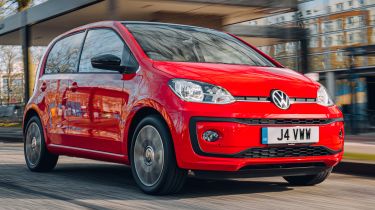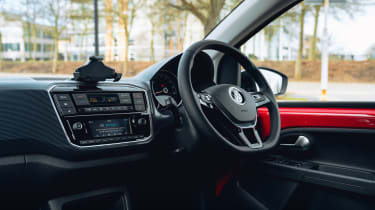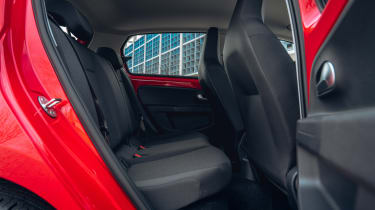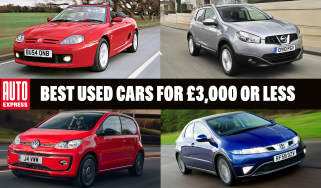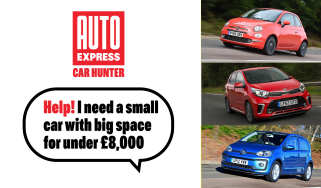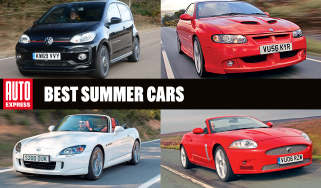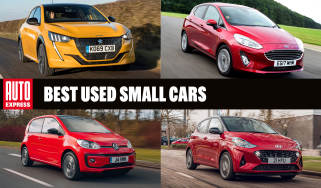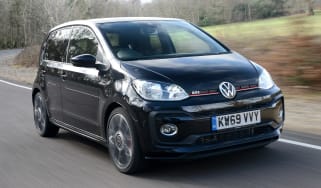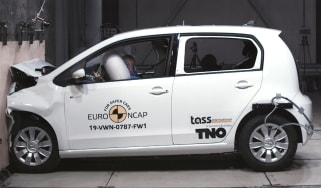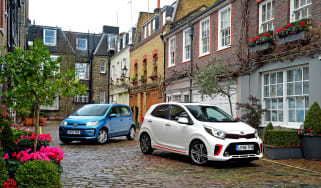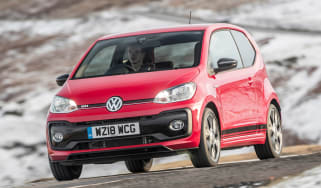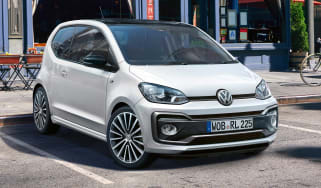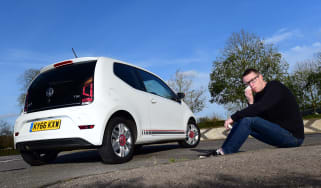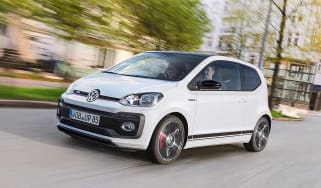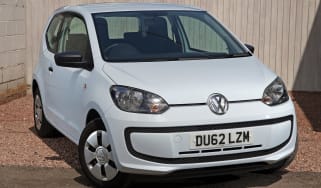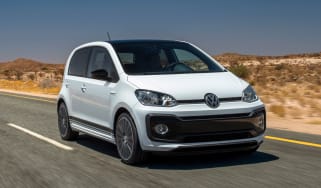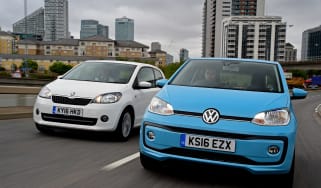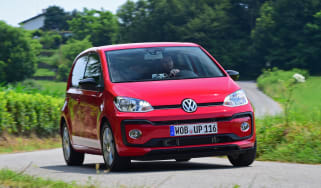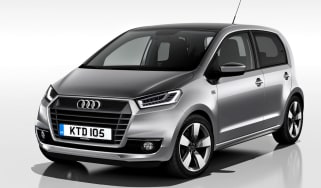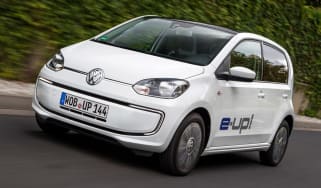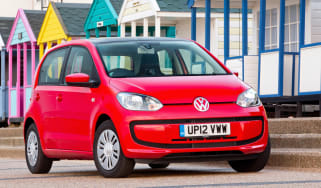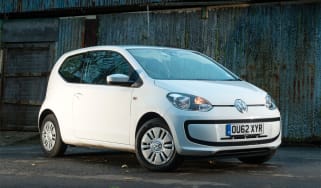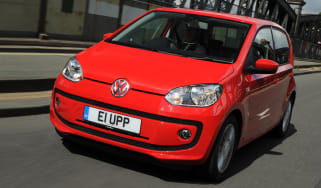Volkswagen up! (2012-2023) review
The VW up! has been at the top of the city car class for a decade, and it’s still going strong

This is a review of the 2012-2023 Volkswagen up! If you are interested in information about a used Volkswagen up!, please follow the links provided.
The Volkswagen up! is more sophisticated than its size and looks suggest. It’s comfortable, feels stable on the road and is enjoyable to drive. It’s designed to work in town, but it's not overwhelmed by or underpowered for the occasional motorway trip, although the long gearing does make it hard work.
The now-discontinued up! GTI and fully electric e-up! also showcased the up!’s formidable breadth of talents. But even with them gone, and after being on sale for more than a decade, the dinky VW continues to be one of the best city cars you can buy, though it's far from the most advanced model we've ever tested.
About the Volkswagen up!
Volkswagen introduced its little up! city car in 2011, and it’s been one of the very best in its class ever since. That remains true today if you want a petrol-powered city car, although the fully electric Fiat 500 won our City Car of the Year award twice thanks to its blend of style, tech and all-round appeal. But being the class benchmark for as long as it was is still a pretty impressive achievement.
Used - available now

2018 Audi
A5 Sportback
104,839 milesAutomaticDiesel2.0L
Cash £12,299
2022 Toyota
C-HR
8,248 milesAutomaticPetrol1.8L
Cash £24,168
2022 Mazda
CX-30
35,792 milesManualPetrol2.0L
Cash £14,968
2017 Kia
Sportage
42,777 milesAutomaticDiesel1.7L
Cash £13,665Changes VW made to the up! back in 2016 created a classier and more customisable car, and included a switch to a smartphone sat-nav system in the hopes of appealing to younger buyers. The up! remains as refined and practical as ever, but we found the updates to the gearbox resulted in slightly sluggish performance with no real gains in efficiency. It was also disappointing when VW dropped Autonomous Emergency Braking from the up!'s spec sheet in 2019, causing it to fall from a five to a three-star Euro NCAP crash safety rating.
Nevertheless, over the years the smallest VW has seen off a roster of rivals that in the past included the three-pronged attack of the Citroen C1, Peugeot 108 and Toyota Aygo joint venture partners, as well as the up!'s near identical sister cars: the Skoda Citigo and SEAT Mii. However, times have changes and all five of these cars have been axed at this point.
Today, the dinky VW's key rivals are the impressive Kia Picanto and Hyundai i10, plus the previous-generation Fiat 500 which is still on sale with a hybrid powertrain while the new generation is electric-only. The Aygo's SUV-inspired replacement, the Aygo X, is another competitor in the city car class. Other ways to spend a similar amount of money include the Dacia Sandero and Citroen C3 superminis, and Suzuki Ignis SUV.
As we mentioned, the up! line-up has shrunk in recent years with the sporty up! GTI and fully-electric e-up! no longer available to order. You can still order a three-door up! but only in the base trim, while the five-door model is offered in a choice of up!, Black Edition, Beats and R-Line specifications. At the time of writing, prices start from close to £15,000, so it's still one of the cheapest cars on sale in the UK.
The base model comes with 15-inch alloy wheels, a five-inch dash display screen, a smartphone cradle and manual air-con. Black Edition cars get 16-inch alloy wheels, unique dash design and tinted rear glass, Beats trim adds a 300W six-speaker sound system, different wheels and body decals, while the R-Line has lowered sports suspension, fog lights, heated seats and electric mirrors.
The only engine available in the up! at this point is a 1.0-litre three-cylinder petrol engine producing 64bhp that's paired with a five-speed manual gearbox.
Engines, performance and drive
The small size of the up! means it lends itself perfectly to navigating the narrow streets and tight car parks, so it fits the brief of a city car very well. The tight turning circle makes it particularly good for nipping in and out of traffic and it’s a doddle to park.
The VW's chassis delivers a superior level of grip. The up! is a genuinely entertaining little car to drive, and allows you to carry more speed into corners than you might imagine or than its rivals can manage.
This precision is matched by a level of refinement and composure that just shades the Kia Picanto. At idle the engine isn’t quite as smooth as the Kia’s, and it’s a little noisier when revved, but drive sensibly in town and on the motorway at a cruise, and the VW is easy to get on with and more refined than the Picanto.
Harsh jolts do upset the VW’s chassis, but that’s no surprise. The up! deals with these intrusions adeptly and smooths out poorer surfaces more competently than the Picanto at lower speeds. At higher speeds the damping feels more plush, with well controlled reactions to bumps.
0-62mph acceleration and top speed
It may be dinky but with the 1.0-litre engine under the up!'s bonnet producing just 64bhp, 0-62mph takes an arduous 15.6 seconds while the top speed stands at 101mph. The now-discontinued GTI version produced 113bhp from the same engine and achieved the same sprint in a more impressive 8.8 seconds as well as a 122mph top speed.
The fully electric e-up! model is zippy around town and almost as fun to drive as the petrol models, but is more at home at slower speeds. It starts to feel out of its depth on the motorway, while faster driving runs down the electric range more quickly.
MPG, CO2 and running costs
If you order a Volkswagen up! today the only engine available is a 1.0-litre three-cylinder petrol motor that produces 64bhp and produces CO2 emissions of up to 119g/km. According to Volkswagen, the three-door up! can deliver a maximum combined economy of 55.4mpg, while the five-door version will return 54.3mpg at best.
Volkswagen doesn’t offer a diesel or hybrid engine with the up! and the 113bhp up! GTI is no longer available to order. If you buy a secondhand example of the GTI though, it's only slightly less efficient than the less sporty models, rated to deliver 51.4mpg and emit 125g/km of CO2.
The fully-electric e-up! is no longer part of VW's line-up, either. But again, find a used example and the 36.8kWh battery in newer models should allow for a maximum range of 159 miles (based on the WLTP test cycle that is), while older models can cover less than 100 miles on a single charge.
Insurance groups
Being a small car with a focus on value, the Volkswagen up! is about as cheap to insure as it gets. The entry-level three-door up! sits in group 2 out of 50, as does the base five-door model, while Black Edition, Beats and R-Line variants all land in group 3. As a result, the VW up! will make a great car for learner drivers, who normally pay high premiums to insure their cars. Unsurprisingly, premiums will predictably rise if you opt for the GTI, as this sits in group 17.
Depreciation
The Volkswagen up! is predicted to keep around 55 per cent of its original value after an average ownership period of three years and 36,000 miles.
To get an accurate valuation on a specific model check out our FREE car valuation tool...
Interior, design and technology
Form followed function when it came to the styling of the VW up!, with its slab sides, upright tail, steeply raked nose and wheel-at-each-corner stance allowing designers to maximise space inside the compact body. Yet the overall result was a surprisingly smart and classy-looking city car, so VW wisely decided not to mess with a winning formula when it was updated in 2016.
At the front you’ll spot the deeper front bumper with chunky black trim inserts, plus the addition of LED running lights that are set into the existing headlamp units. Move around to the rear of the car and you’ll discover the subtly redesigned tail-lamps that sit either side of the glass-clad tailgate that is a visual trademark of the up!.
The interior of the up! is simple yet high-quality and it can be specified with body-coloured panels. The piano-black finish on the steering wheel and dash also looks great, but it does reflect the light in sunny weather and can be a distraction.
In addition, VW has introduced some customisation upgrades, allowing buyers to choose from a variety of bold dashboard finishes that contrast with the body-coloured trim inserts on the doors. In all other respects, the interior is identical to the old car’s, which means you get classy materials and solid build quality.
Sat-nav, stereo and infotainment
Up front, there's no touchscreen like you get in a Ford Fiesta or Fiat 500, just a simple display screen for the radio and some other small functions but it’s high-res and has a clean, classy look.
The up! uses a smartphone app to deliver sat-nav, as there’s no integrated unit available. You dock your smartphone in a cradle on top of the dash, while the free Maps+More app gives you access to sat-nav – which features traffic updates – and VW’s Think Blue Trainer to give you eco coaching on the move. The system isn’t perfect, though. The app can often work slowly, and we found it didn’t respond well to destination entry.
Of course, there's nothing stopping you from using Google Maps or Apple Maps for navigation if you prefer, plus your music, Bluetooth and other infotainment functions can be controlled through the regular dash-mounted buttons.
The up! Beats also gets an upgraded 300w stereo with seven speakers, including a subwoofer in the boot and a digital sound processor. It’s a punchy system for a city car. This model also gets a choice of black or red finishes for its alloy wheel centre caps, door mirrors and bold body decals to mark it out from the rest of the range.
Practicality, comfort and boot space
The up! is available as a three or a five-door hatchback with four seats and the compact but spacious layout means it’s perfect for short journeys and young families. The up! isn’t as big inside as the Polo supermini, but the versatile interior should prove practical enough. The comfortable, upright driving position and good all-round visibility make it very easy to drive. There are plenty of cubbyholes, too.
Dimensions and size
Don't be fooled by the up!'s big-car feel, it is still very compact, with a length of 3,540mm, width of 1,645mm and height of 1,489mm. It is the same size as the Fiat 500, but thanks to its 2,420mm wheelbase, the up! is much more spacious than its Italian rival. For context, the up! is nearly 500mm shorter than the Hyundai i10, Kia Picanto and Ford Fiesta, yet it still manages to offer similar boot space to the Kia and Hyundai.
Leg room, head room & passenger space
The inner roof is shaped to accommodate taller rear passengers. It means that while the up! isn’t exactly a family-sized car, there is quite a bit more space than you’d expect from a car of this size for those in the back seats – and the same goes for legroom. It’s only a four-seater though, so you may want to look elsewhere if you need the extra central seat in the back.
Boot space
The up! has a 251-litre boot and space remains the same for both the three-door and five-door models, though the latter has better access to the rear seats. To achieve this figure you need the false floor in its lowest setting, which creates a high loading lip. All cars bar the entry-level model get split-folding rear seats, which creates a 959-litre load area, and with the floor panel raised the load area is completely flat.
The boot is bigger than the majority of rival city cars can offer, but the Volkswagen is beaten by the Hyundai i10, which has a 252-litre boot that expands to 1,046 litres when the rear seats are folded flat.
Reliability and safety
The Volkswagen up! received the full five-star safety rating in its original 2011 Euro NCAP test. However, the testing procedures have since been adjusted and, when re-tested in 2019, the up! was given a three-star score.
This was largely due to VW deleting the formerly standard City Emergency Braking Pack, along with more rigorous Euro NCAP testing standards. Sadly, Autonomous Emergency Braking is no longer even an option, though all versions of the up! do at least get six airbags, stability control and Lane Assist.
The up! didn’t feature in the 2022 edition of our Driver Power owner satisfaction survey, but Volkswagen itself managed to finish in 18th place out of 29 in the best car manufacturers rankings. The German brand's dealerships also performed admirably coming 10th out of 16 networks ranked.
Warranty
Volkswagen offers an industry standard three-year/60,000-mile warranty with the up!. It’s easy enough to find rival city cars with longer periods of cover if you want them – the Hyundai i10 and the Toyota Aygo both come with five-year/unlimited-mileage warranties and Kia offers seven years and 100,000 miles of cover with the Picanto.
Servicing
Volkswagen offers guidance on fixed and flexible servicing approaches, depending on the age of your car, mileage covered and what type of driving you regularly undertake. The company also offers service plans for the up! that can help spread the cost of regular maintaince.

